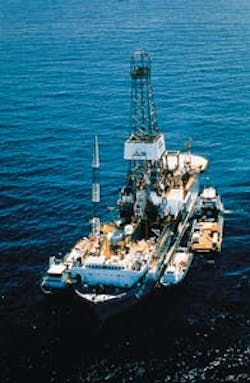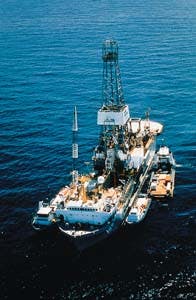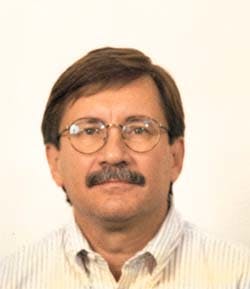Amoco saves $31 million in deepwater drilling operations
P. Michael Harris
Amoco Corp.
Houston
Transocean's Discoverer 534 was used extensively in Amoco's 1997 drilling program and set a benchmark record in 6,403 ft of water. It also holds the water depth record of 7,612 ft set 1996. Continuous operations with this drillship have reduced the learning curve, enhanced safety, and promoted contractor/operator relations (Fig. 5)
About this report
Offshore technologies continue to expand in the Gulf of Mexico and North Sea as articles in this year's OGJ offshore report reveal.Amoco has drilled four ultra-deep wells since February 1997, while a spar built in Finland with two main hull stations weighing 10,4892 and 15,861 tons each is transported from Pori, Finland, to Corpus Christi, Tex.
Off Europe, a dynamically positioned pipelay vessel will begin laying a 42-in. pipeline for Statoil's Europipe II project this month. It will connect German consumers with North Sea gas.
Rounding out the report are articles on an innovative welding environment and the development of a data warehouse.
Continuous cycle-time improvements in every deepwater drilling process, from mobilization to rigging down, saved Amoco more than $31 million in 1997, as compared to 1996 performance levels.Through extensive preplanning, organizational support, integration of suppliers, and technological innovation, Amoco Corp.'s Exploration & Production Technology Group (EPTG) achieved upper-quartile results in the Gulf of Mexico for water depths greater than 5,000 ft.
The main factors that led to a successful 1997 drilling program were:
- Technology
- Organizational structure
- Customer focus
- Front-end loading
- Continuous operations
- Supply chain management
- Continuous improvement
- Safety.
In 1997, the company's ultra-deepwater performance, as measured in days vs. depth, improved by more than 46% as compared to other Gulf of Mexico operators (Fig. 1 [50,643 bytes]). Last year, all but one of Amoco's ultra-deepwater well were directionally drilled.
In addition, Amoco reduced planned drilling time by 44% and downtime by 69%, based on 10,000 ft of hole drilled, while the average number of days spent on these wells declined from 86.9 days in 1996 to 55. 8 days.
Benchmark well
Four ultra-deepwater wells were drilled from February 1997 to January 1998. If these five wells had been drilled with the efficiency of the 1996 program, Amoco would have finished the last well at the end of August 1998, a time savings of 7 months ( Fig. 2 [ 74,217 bytes]).Amoco's best well in the 1997 program set a new benchmark for ultra-deepwater drilling projects. Mississippi Canyon 606 No. 1 was drilled in 6,403 ft of water ( Fig. 3, [79,477 bytes] Table 1).
A total of 57 days were spent from rig mobilization to abandonment. From spud to total depth (TD), it took 34 days to reach 11,347 ft below the mud line. Based on Amoco's 1996 performance, almost $5 million was saved on this well alone.1
Fig. 4 [63,526 bytes] shows a depth-vs.-days plot of the well. The 36, 26, and 20-in. casing intervals were drilled using seawater with viscous gel sweeps. The 16-in. intermediate section was drilled using a novel calcium chloride/polymer mud that successfully alleviated gumbo shale problems typically experienced in this section of the hole.
The last two hole sections were drilled using the latest-generation synthetic-base drilling fluid. The 135/8-in. casing section was drilled with a 143/4-in. bit and then under-reamed in a second run to 171/2 in. with an under-reamer. The 143/4-in. hole was kicked off and drilled with a steerable assembly to obtain a 38° angle at casing point.
This section was drilled and under-reamed trouble free, with an in-gauge hole, and no fluid losses. Some losses occurred, however, while cementing the 135/8-in. casing, caused by an increase in equivalent circulating density (ECD), an effect created by the close tolerances between the well bore and the casing.
Nevertheless, the casing was successfully cemented, and a leak-off test showed a suitable margin between the leak-off ECD and anticipated mud weights for drilling the next hole. The 121/4-in. hole section was drilled at an average penetration rate of 90 ft/hr. The hole inclination was built to 63° at TD. In this section, a 90 ft, 4-in. conventional core was cut with full recovery, and the well was logged at total depth for almost 5 days with no problems.
Technology
Application of technology is absolutely critical in deepwater operations. Young, fragile formations exhibit low fracture-gradient to pore pressure-gradient differentials. Reactive gumbo clays in the upper and intermediate-hole sections cause bit balling and produce restrictions within the well head and riser.Stuck pipe, lost circulation, hole cleaning, and washouts are some other problems that cause down time and high costs. The low temperatures encountered in the deepwater environment, coupled with high wellhead pressures, have caused standard oil-based muds to become viscous. Water-based muds suffer from hydrate formation under these extreme conditions of pressure and temperature.
In the deepwater, Amoco combated some of the problems in the lower hole sections by using a new-generation, synthetic-based mud. In early wells, there were concerns about the extreme cost of lost circulation. To prove the viability of this mud with respect to its properties in the well bore, it was felt that accurate knowledge of actual downhole pressure regimes was critical in understanding and controlling the ECD.
Amoco used a proprietary software package to calculate ECD, static-fluid densities, frictional pressure losses, and pump pressures. Using a pressure-while-drilling tool in the course of the first well, the calculated values were verified to within 0.07 ppg of actual measurements.
To combat gumbo problems, a novel calcium chloride/polymer drilling fluid was employed. This fluid exhibited superior solids encapsulation and well-bore inhibition. These properties eliminated the problems of bit and bottom-hole assembly balling and the accumulation of gumbo in the wellhead and riser.
One problem exhibited by this fluid was shaker-screen blinding, which allowed an excess of drilling fluid to run over the shakers. The blinding problem is under investigation and it appears that a reformulation of the drilling fluid may mitigate the blinding while not severely affecting the encapsulation and inhibition properties.
Well-bore stability techniques have been successfully used not only in the Gulf of Mexico, but worldwide, to deal with lost circulation, hole enlargement, poor hole cleaning, drillstring fatigue, hole caving, and stuck pipe conditions. Warning signs and corrective action are used to deal with chemical and mechanical instability.
Selecting the proper mud types and compositions prevents chemical-stability problems as follows:
- Various salts can be used to balance water activity.
- Glycol can be used to reduce the chemical reaction of water to shale.
- Various coating polymers can be applied to reduce water contact with shale.
- Synthetic oil-based muds can be formulated to exclude water contact.
State-of-the-art software and pressure-while-drilling tools have been used to prepare for and anticipate upcoming formation-pressure changes. Amoco strives to identify potential drilling problems during the well-planning stage so that prevention and operational planning can be developed in time to minimize costs associated with well-bore stability problems.
Various techniques are used to determine the magnitude of in situ conditions. Density data from offset wells help to determine overburden, while seismic logs are used to calculate pore pressure real time. Core tests or logs are also used to determine rock strength, and other offset well data are used to identify stability symptoms.
Organizational structure
A key success factor in Amoco's worldwide drilling and completions activities, directly affecting Gulf of Mexico operations, has been the maintenance of a central drilling organization. 2 Centralization allows Amoco to maintain drilling and completions activities as core competencies within the corporate structure, and thereby attract, motivate, and retain the best professionals who wish to maximize career choices.Benefits of a centralized organization include:
- Mobility and speed of applying resources where needed (personnel and technology)
- Organizational learning
- Personnel development
- Supply chain management.
Amoco EPTG provides exploration and production-technology products and services on a fee-for-use basis to the E&P sector. Within this framework, EPTG-Drilling supplies drilling and completions service and personnel to the other business groups within Amoco's E&P sector including:
- Amoco Energy Group North America-Includes the offshore business unit that handles deepwater production
- Amoco Energy International-Includes the worldwide exploration business group that explores in deepwater and the international energy operations group, responsible for non-U.S. production operations.
- Amoco Eurasia.
In the offshore business unit, EPTG-Drilling has two drilling managers who are responsible for drilling and completions operations on the shelf and deepwater. The shelf and deepwater groups are made up of engineering teams and rig-site supervisors who are responsible for specific projects or areas.
These teams generate specific improvement goals, in conjunction with their business units' customers, and are held accountable for their performance.
Market-based pay has been implemented for all drilling and completions professionals, and in the case of those serving the offshore business unit, retention programs have been implemented. Additionally, a bonus structure has been put in place for rig-site supervisors.
Customer focus
Within a centralized organization, one challenge is to preserve the benefits of a decentralized organization, including customer intimacy, internal supply chain communications, goal alignment, and rewards, while retaining the advantages of centralization.Amoco EPTG-Drilling preserves these characteristics by placing the drilling and completion teams in close proximity with the customer and by using the principles of goal setting and score carding to ensure that the customers' needs are met.
With their customers, each team develops score cards that measure and record time, costs, quality (data or production capability), and communications information; in other words, information that is related to the customer's success. Score cards are used to determine the incentive bonuses for all EPTG-Drilling employees.
EPTG-Drilling's vision has evolved from focusing on customer intimacy or ensuring customer happiness, to focusing on customer success or ensuring that performance levels positively affect the customer's business results.
Drilling professionals are sometimes criticized for maximizing drilling rates to the exclusion of broader well goals. EPTG-Drilling has a score-card mechanism in place designed to facilitate goal alignment. This is because when a company focuses on the customer's needs, it actually helps to create an environment for superior technical performance.
These factors are mostly interdependent, although there are occasional conflicts that must be managed to ensure optimum results in any drilling or completions program.
Front-end loading
Front-end loading is a process where all stakeholders-geologists, engineers, customers, and management-are brought together early in the conception stage, for preplanning purposes. It is only during this time that a high level of flexibility is available to make changes to the drilling program, and the closer a project moves towards the operational stages, the less flexibility there is to make well-construction changes.Front-end loading utilizes proper resources at the right time with the right tools. There are many examples of its effect on drilling and completions operations, especially in terms of costs and safety. There are also examples of negative effects created by inadequate planning.
Several factors have allowed Amoco to properly and successfully front-end load deepwater prospects. The ability and experience level of personnel ensure that they understand the pertinent work processes, and just as important, the work processes of their customers.
One challenge is knowing when to become involved in the customer's work processes, and when and how to adequately staff this involvement. The use of a stage-gate planning process has had a positive effect on the ability to properly plan projects, especially when multidisciplinary teams are involved.
Continuity of operations, such that improvements from previous operations can be implemented timely and efficiently, has had a large beneficial effect on planning.
Uninterrupted operations using the same people and equipment result in tremendous efficiency gains and synergism. The other success factors mentioned here are not nearly as pronounced in discontinuous projects as they are in continuous operations.
Amoco has experienced as much as a 50% loss of efficiency when programs are discontinuous and sporadic. Also, when discontinuity occurs, resulting data clearly show a remarkable deterioration in safety and performance.
The continuity of strategy and operations in deepwater drilling has been a major factor in Amoco's success. For instance, Amoco used the Transocean Discoverer 534 for all ultra-deepwater drilling projects in 1997, its first full year of continuous operations with Amoco (Fig. 5 [15,682 bytes]).
Supply chain management
EPTG-Drilling considers a number of components critical for a successful project, including the drilling rig, drilling fluids, data acquisition, cementing, drilling tools, and services. The personnel involved in providing these services contribute to more than 50% of EPTG-Drilling's planning and engineering effort.These service providers have been integrated into Amoco's work processes and most have personnel in Amoco's offices either full or part time. It has become imperative to attract and retain strong individual performers from these service providers.
Strong performance by suppliers in deepwater has been influenced by a heightened emphasis in training and technical communications, both on the rig site and in the office. An Amoco/rig contractor steering committee was formed to set goals and ensure technology and idea transfer between teams.
An example of improved work processes is shown through the use of efficiency worksheets at the rig site. These worksheets have become the tools for rig-site efficiency teams who define and document actual-vs.-predicted time results. This information is used to improve future operations. Also, mapping near misses and identifying root causes has resulted in enhanced safety awareness.
Long-term involvement by critical suppliers has given them a sense of ownership and pride in Amoco operations. Their motivation in some cases has been enhanced by selective use of incentives.
Efforts of continuous-improvement within Amoco can be examined in terms of the Baldridge criteria of business results, customer focus, process improvements, measurements, assessment, leadership, teamwork, empowerment, and shared learning. Many of these properties are evident in the success factors discussed previously.
Amoco, EPTG, and EPTG-Drilling have actively developed a program to develop a continuous-improvement culture within the organizations. Staff members have been trained in teamwork, mapping, score carding, and all the tools of total quality management. People that actively use and champion these tools are rewarded.
The future
Deepwater prospects hold great promise for operators who can develop them economically; however, high risks and costs associated with such operations have the potential of turning technical successes into financial failures.Many of these challenges include:
- Rig fleet availability
- Performance of upgraded and new rigs
- Shortage of engineers, rig crews, and other drilling and completions professionals
- Increased activity and workload in the service and supplier arenas
- Cost increases because of supply-and-demand pressures
- Pressure to reduce internal operating costs
- Technical problems.
Limited resources will only worsen this situation in the near future. One step Amoco has taken to address its future needs for ultra-deepwater drilling capabilities, in water depths between 7,500 ft and 10,000 ft, is to construct a next-generation drillship.
This design allows operations to proceed in a "dual-activity" mode, with drilling operations on one side, and ancillary operations, like bottom-hole assembly and tubular preparation, occurring on the other.3
During initial well-construction operations, one rotary can drill the hole riserless while the other runs the blowout preventers and riser. Drilling assemblies will be made up and stood back while the preventers are being tested.
During the drilling process, the second rotary will make up and stand back casing in triples, make up float equipment and the subsea wellhead, and pressure test. Drill pipe stands can be set back in quadruples.
The hours associated with all these tasks will be saved from the total well time. Similar procedures will be used for subsea completions and testing of deepwater wells. The Discoverer is scheduled for sea trials in October 1998. Amoco's overall goal is to reduce well construction time by 40% in the upcoming program.
Acknowledgments
The author wishes to thank John Pantaleo, Toby Wood, and the EPTG-Drilling deepwater drilling and completions team for ITS help in preparing this article.References
- Wood, Toby, and Billon, Brad, "Amoco Reduces Trouble Time, Costs in Ultra Deepwater GOM," The Brief, March 1998.
- Boykin, G.F., "A Global Organization: The Role of the Drilling Professional," SPE (39359). Presented at the SPE/IADC Conference in Dallas, Mar. 6, 1998.
- Cole, J.C., Herrmann, R.P., Scott, R.J., and Shaugnessy, J.M., "New ultra-deepwater rig with dual rotaries will reduce costs," OGJ, p. 69, May 26, 1997.
Mike Harris is operations manager for Amoco Exploration & Production Technology Group. He is responsible for drilling and completions operations in the Gulf of Mexico, as well as the Caribbean and South America. Harris has more than 18 years' experience in operations and management with Amoco. Previously, he was the drilling manager for Amoco in the U.K., regional drilling superintendent in Denver, drilling manager in the Netherlands, and Drilling Superintendent in Oman and the Philippines. Prior to his service with Amoco, Harris worked for Exxon Chemical Specialties and Exxon Production Research Co. Harris holds a BS in chemical engineering from the University of Arkansas.
Copyright 1998 Oil & Gas Journal. All Rights Reserved.


